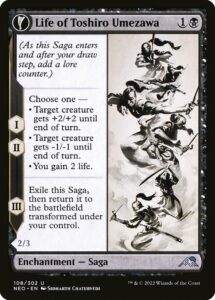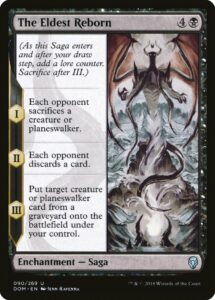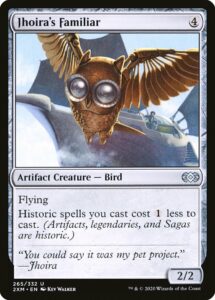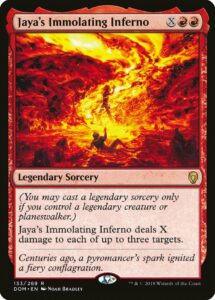With Dominaria United preview season kicking off this week, now seems a perfect time to revisit 2018’s Dominaria.

Two challenging, triumphant returns
Dominaria was in many ways a precursor to Kamigawa: Neon Dynasty. Both sets featured a world not seen in over a decade and saddled with baggage, though the nature of that baggage differed substantially. Kamigawa was a world of at-best-mixed popularity (which had grown more popular with age), beset with mechanical and power level issues, and endured heavy growing pains from being Magic’s first true top-down block. Those were major hurdles, but the world was unambiguously coherent.
Dominaria, on the hand, was most certainly not coherent. From Magic’s birth in 1993 through 2003’s Mirrodin, Dominaria was the setting for almost all sets and stories (with some diversions to Ulgrotha, Rath, Mercadia, Phyrexia, Serra’s Realm, and, retroactively, Rabiah). It was home to the snow-covered lands of Ice Age, the savannahs and jungles of Mirage block, Rath’s flowstone remants from Tempest, the magical academies of Urza’s Saga, the planar conflict of Invasion, the edgy arenas of Odyssey, and the Mirari-mutants of Onslaught—not to mention the lands of Shiv, Corondor, Kroog, Madara and the interplanar rifts of 2007’s Time Spiral.
Dominaria contained everything, making it impossible to revisit without ignoring the vast majority of its content. Adding to the challenge, Dominaria was the first set in the blockless paradigm, meaning Wizards of the Coast had to accomplish this incredible feat not across a two or three-set block, but in a single set.
They succeeded wildly. In 2018, Dominaria returned to the forefront of Magic after a decade-long absence (okay, it was one of the ten worlds featured in 2015’s Magic Origins) with an amazing Limited environment and a visually coherent world defined by its history. That is, in a nutshell, exactly what Wizards of the Coast repeated four years later with Kamigawa’s massive success. And as we’ll discuss, the similarities go deeper, as both sets were defined by fairly restrained mechanics. Which is a perfect segue to go into Dominaria’s three new named mechanics: Sagas, Historic, and Legendary Sorceries.

Telling stories
Sagas are one of the most significant new mechanics of the past decade. Since its introduction in 2018, the Saga has become an annual, deciduous mechanic, returning in 2020’s Theros Beyond Death, 2021’s Kaldheim, and 2022’s Kamigawa: Neon Dynasty. It’s an amazing track run for a mechanic built from the leftovers of early Planeswalker design.
At first glance, I’d imagine that Sagas have fairly narrow design space. Each one needs at least two, usually three chapters, all of which need to synergize with each other, tell a coherent story, and be distinct from other Sagas. In practice, the design space seems fairly deep thanks to their being top-down stories. Magic can use both established Magic lore (Dominaria and Kamigawa) or resonant source material (Theros and Kaldheim) to stitch together a mechanically odd tale into something thoroughly coherent and exciting.
Sagas have enjoyed both relatively simple innovations in changing the number of chapters (Theros) and making them multicolor (Kaldheim), as well as a more substantial change in Kamigawa by becoming double-sided creatures. All of this suggests the mechanic is capable of supporting many more returns while also helping to tell and retell the events that shaped Magic’s many planes.
The only substantial concern I have about Sagas is one of balance. Unlike creatures and removal spells, it’s difficult for a Saga to not generate card advantage or disadvantage. In Limited, Sagas tend to be either exceptionally powerful or underpowered/narrow. Prior to War of the Spark, that might have seemed a serious challenge, but Sagas function somewhat similarly to uncommon Planeswalkers—while they warp an environment, we know that they can do so in a balanceable manner.
With those two nits thoroughly picked, I have nothing but praise for the mechanic. Sagas tell coherent little stories, they inject flavor into both games and worldbuilding, and they have many more available innovations and tweaks to deepen their design space. I expect Sagas to return again and again.

The glue, not the centerpiece
Sagas might be among the most significant mechanics of the past decade, but Historic ranks among the biggest innovations. Sagas are a great mechanic to keep bringing back, but Historic opened up a new design vein. It introduced batching, leading to further batching mechanics in Party and Modified. Batching ties together multiple (usually three) disparate components into a unified whole. This allows for coherent archetypes which flexibly unite disparate components (unlike, say, tribal strategies that require very specific card types or A+B mechanics like Madness that require specific ratios) while providing backwards compatibility (allowing 2018’s Sagas to nicely coexist with artifacts from as far back as ’93 and legends from ’94). Historic unlocked brand new design veins tailor-made to address current Magic’s needs for both backwards compatibility and Commander archetypes that don’t require six or seven times a mechanic’s normal density.
For all its importance to future Magic design, Historic has yet to make a return. That’s not terribly surprising, since even the best non-deciduous, non-evergreen mechanics often go more than four years before returning (see Cycling, Flashback, Split Cards). Historic may well be the mechanic associated with Dominaria and so could well have been waiting to return until Dominaria United or Brother’s War.
Still, the mechanic isn’t the easiest to just plop into a set. It demands much of a set’s structure, especially in requiring the inclusion of Sagas (mechanics can be both confusing and unappealing when they refer to nonexistent components). Moreover, Historic hasn’t demonstrated itself to be an exciting mechanic whose return will spark enthusiasm—by its nature, it’s a glue mechanic that exists to hold other, more exciting parts together. Workhorse mechanics like Historic and its descendant, Modified, aren’t meant to hold the spotlight the way that Sagas, Devotion, and Flashback are. Finally, it might be slightly more awkward for Historic to return given that there it now shares its name with a Magic Arena Constructed format.
Historic and Sagas are two deeply valuable mechanics, but of vastly different utility. Sagas are a great, fun mechanic that will likely return again and again. Historic isn’t nearly as sexy and won’t reappear often, but its descendants are sure to do so, providing vital structural glue between flashier mechanics. The two perfectly illustrate two different ways that mechanics can succeed wildly.

The one we don’t talk about as much
Legendary Sorceries were the mechanical miss of Dominaria. They weren’t a dramatic failure or anything, they just were the weakest part of an exceptionally strong design. They’re certainly an improvement on their precursors, the Epic spells of Saviors of Kamigawa. And they’re well incorporated into Dominaria thanks again to Historic tying them into its fabric.
The trouble with Legendary Sorceries is threefold. First, and likely biggest, they play completely differently from all Legendary permanents. Legends are restricted to one in play on your side at a time, while Legendary creatures have the benefit of being Commanders (Planeswalkers too in Brawl). Legendary Sorceries require you to have a viable Commander to be played. Sure, there are specific Legendary interactions they play into (like Historic, Captain Sisay, Niambi, Esteemed Speaker), but Legendary Sorceries’ connection to other Legends is quite tenuous and that awkwardness can be felt by players.
The second issue is Legendary Sorceries’ fail rate. In Limited, it could be hard to have a Legendary enabler available at the time you wanted to cast your Legendary Sorcery, leaving you with a powerful, utterly uncastable card. That massively low floor simply isn’t a fun play pattern, especially for what’s intended to be an exciting and powerful spell.
Finally, there’s the issue of power level. While it’s hard to guarantee an enabler in Limited, in Constructed, the hoop can be facile to jump through. Accordingly, being Legendary doesn’t justify a significant power boost—that’s true both for permanents and sorceries, but Legendary Sorceries incur a major downside that Legendary permanents don’t. The end result is less than the sum of its parts, where sorceries end up being strictly weaker for being Legendary. So, while I appreciate Wizards’ attempt to find another way to make Legends matter, I’m skeptical that we’ll see Legendary Sorceries again outside of a one-off card in a Modern Horizons or Commander deck.
And, that covers Dominaria. Two incredible mechanics and one mostly forgettable (but not damaging) miss. Historic was fairly unassuming, Sagas were highly appealing, and both helped remodel a muddled world into a specific, recognizable world that embraced its heritage. Four years later, much of that same formula would be reused to reimagine Kamigawa, with Sagas and two versions of Historic (Modified and unnammed Harmony mechanic) holding the set together.
I fully expect not only the constituent components to keep returning, but also for the overall formula to return and revitalize other worlds, perhaps Tarkir or Alara. But now it’s time to close Urza’s Tome and look forward to the future, where we’ll soon enough see Urza’s influence once again.
And, as always, thanks for reading.
Zachary Barash is a New York City-based game designer and the last commissioner of Team Draft League. He designs for Kingdom Death: Monster, has a Game Design MFA from the NYU Game Center, and does freelance game design. When the stars align, he streams Magic (but the stars align way less often than he’d like).

